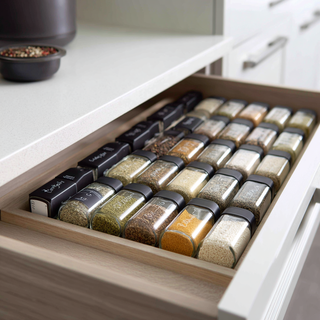Introduction
We've all been there: you're in the midst of prep work, pan on, and you stretch over to get the cumin—only to discover it stuck behind three jars of paprika and an almost-full jar of cinnamon. Spice cabinets are the most cluttered corner of the kitchen. Unlike big, stackable plates or pots, spice jars are little, quirky-shaped, and in number, they come in bulk. Without a system of ordering, they are amassing piles of disorganization that are weighing you down and frightening meal planning too much.
Organizing a spice cabinet isn’t just about neatness—it’s about creating a functional cooking environment that saves time, prevents waste, and elevates the overall kitchen experience. In this guide, we’ll explore practical strategies and clever storage ideas that truly work, whether you’re a casual cook or a dedicated foodie with a global spice collection.
Why Organizing Your Spice Cabinet Matters
Before we hurry on to solutions, let's learn why spice organization is well worth the time.
An organized spice cabinet is time-saving. It's simple to find oregano without rummaging through dozens of bottles. It's also cost-saving—how many times have you bought a second of thyme because you couldn't find one you already have? Storage also safeguards against loss of flavor. Spices that have been in the sun or have been heated for decades are useless. By placing them where they belong and shaking them from time to time, you will gain the most benefit from them.
Aside from usability, a tidy spice cabinet also brings a new kitchen atmosphere. Organizing rows of jars in neat labels converts the initial chaos to tidiness. The sense of tidiness feels warm and cozy, and cooking will be enjoyable with everything at reach of fingertips.
Step One: Taking Control of Your Spice Rack
Start by taking the lot out of the cupboard into the table. Take out all that is in packets, tins, and jars. There are always a couple of surprises in this exercise: doubles, nearly full packets, and spices past their sell-by dates.
-
Check for dates. Whole spices can be stored for approximately 4 years, ground spices for approximately 2–3 years. Once they have lost their scent, it is time to renew them.
-
Organize according to usage frequency. Most used staples like salt, pepper, garlic powder, and paprika upfront. Less frequently used spices like fenugreek seeds or saffron back or towards the top.
-
Standard jars. Bulk packaging comes in large varied shapes and sizes. Everything in standard jars looks neater, but is easier to stack and label. Airtight-sealing glass jars are perfectly adequate right out of the package.
Storage Solutions by Cabinet Type
Pull-Out Spice Cabinets
Shallow, narrow pull-out pantries pull out from the front, and oils and spices are within easy reach. They're even mounted alongside the stove, where they're handy. That access is the biggest advantage—no secret stash of teeny jars somewhere way in the back of the dark. They function just as well in small kitchens where there is no space to spare.
Drawer Spice Organizers
Instead of laying jars on their side, drawer organizers enable you to lay them at an angle. You'll want to be able to read labels. Cooking zone drawers are perfect for the cooks who use more than one spice to make a dish. Drawer inserts keep jars from rolling and the whole set of jars from looking disorganized.
Don't overlook the interior of your cabinet doors. Adding thin racks there provides instant storage. It is an excellent option for renters or for anyone who does not want to invest in complete cabinetry renovations. Simply make sure that the racks are not so deep that your doors will no longer close properly.
Lazy Susan Turntables
Perfect for corner shelves, a lazy Susan will spin so you can reach spices in the back without spilling. Many newer models have multiple levels to take advantage of vertical real estate.
Tiered Shelf Risers
Think of them as stadium seating for spices: shorter jars in front, taller jars elevated in back. Risers are inexpensive and effective, especially in wide cabinets. You’ll be able to see every label instead of losing track of what’s hidden behind the first row.
We carry all types of RTA cabinets mentioned above, from pull-out spice racks to Lazy Susan organizers and more. No matter your kitchen size or style, you’ll find the right solution with us.
Clever Organization Ideas That Really Work
Once you’ve chosen the right cabinet solution, the fun begins—deciding how to arrange your spices.
Some cooks prefer alphabetical order, which guarantees you’ll never waste time searching for “turmeric.” Others prefer categorical organization—grouping by cuisine (Italian, Mexican, Indian) or function (baking spices, grilling blends, everyday basics). Choose whichever system aligns with your cooking style.
Labels do make a big difference. Label-free bottles with identical jars are soon a crapshoot. Large, legible labels—printed or handwritten on—do make a big difference. The majority want to be professional-looking and buy coordinated sets of labels that are made specifically for spice jars.
When there's no shelf space, use magnetic spice jars. These can be taped on the fridge side or metal wall-mounted strip, freeing up your shelf space. It's a clean, minimalist solution and also serves as kitchen decor if positioned in a stylish manner.
Above all, place your most frequently used spices where you can see them. No amount of beautiful looks can make up for the functionality if you are reaching over and over and over to pull out a step stool just to get to the salt.
DIY Spice Cabinet Hacks
You need not spend an arm and a leg re-designing spice storage. A couple simple DIY hacks are all it takes to turn spice storage around:
-
Mason jars: Cheap, simple, and air-tight. Repurpose to repackage bulk spices purchased at specialty stores.
-
Repurposed boxes: That box or even shoebox with dividers can be a speedy drawer organizer.
-
IKEA hacks: Affordable shelves or racks can be stylish spice organizers with some outside-the-box thinking.
-
Custom risers: Handy with a wrench? Build risers to your cabinet dimensions for a fit that's the perfect match.
These frugal tips bring spice organization to all budgets.
Your Organized Spice Cabinet: Maintenance
Organization isn't a fixed state—it takes maintenance. Don't worry, though; with good habits, it doesn't have to be difficult to remain organized.
-
Check in on it every now and then. Search for stale spices and dirty jars every three months.
-
Dry it out. Spices should be kept in a dish that is not wet or in direct heat. Dishwashers and stoves in close proximity will shorten shelf life.
-
Use "one in, one out." When putting a new spice in, allow the old spice to be nearly full or near its expiration date before putting another jar in.
-
Coordinate returns. Return the spices to their place after opening rather than leaving them sitting on the counter.
These small habits keep your cabinet from getting cluttered again.
Real-Life Inspiration: Mixing Function with Style
Your spice cabinet does not have to be functional; it can be beautiful. Jars of bright yellow turmeric, red paprika, and herbs in colored bottles make a rainbow effect. Showcase them with open shelving or glass-fronted cabinets.
Distressed wood shelving contributes to interior warmth in farm kitchen design. Quirky tin storage bins with plain tin utilitarian bare basic simple labels give way to linear cabin silhouettes for contemporary kitchens. Regardless of your sense of style, spice can be integrated into overall design and not a blind spot afterthought.
And if you’re looking to tie your spice cabinet seamlessly into the rest of your kitchen, consider coordinating with timeless cabinet colors. White shaker cabinets create a clean, bright backdrop that makes your spice jars pop like art. Green cabinets bring a fresh, organic energy, perfect for kitchens that lean natural or farmhouse-inspired. For a more dramatic statement, blue cabinets add depth and sophistication while still allowing your spice cabinet to feel intentional and stylish.
Final Thoughts
Spice cabinet organization is a small detail in the overall scheme of kitchen layout, but its influence is big. Time and money are saved, flavor and beauty are enhanced, and a well-designed spice collection is a treat for you.
Whether you dish out a lot of money for a bespoke pull-out cabinet, repurpose an existing box as a DIY drawer insert, or simply alphabetize and label your jars, the goal is to get it to work for you. And when you do, cooking will be easier, more pleasant, and maybe even slightly more creative.
So take an afternoon, battle through the clutter, and organize your spice cupboard so beautiful that you can barely wait to open it each time.
While the spice cabinet might be the smallest corner of your kitchen, it holds the heart of your cooking. And if you’re planning a larger kitchen makeover or struggling with design choices, our kitchen free design service is here to help. At HomeCabinets, we’ll guide you through every decision—from spice storage to full cabinet layout—so your kitchen works beautifully in both function and style.

























